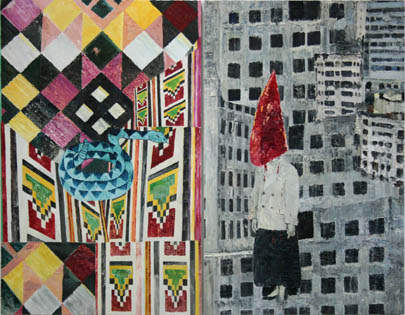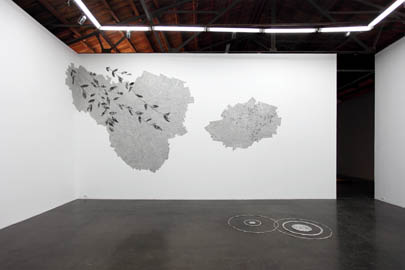SEVEN YOUNG ARTISTS & TRAILER
| June 1, 2010 | Post In LEAP 3


But if we want to talk about the shows themselves, they share something on the level of their calm, restrained and dignified dispositions, although “Seven Young Artists” emphasized a delight in language and the expressiveness of things, while “Trailer” saw these simply as starting points for multiple unfolding narratives. For example, even though both shows displayed the work of Hu Xiaoyuan, her silk painting at Beijing Commune made one think that the artist had already withdrawn outside her work, while in her video at Boers-Li of a girl using a quilt as a prop to imitate the wriggling motions of an insect larva, one could still find something a little closer to Hu’s essence.
While we can only say that Hu Xiaoyuan’s double booking represented yet another coincidence between the two shows, this coincidence nonetheless spoke to the effect each show’s vibe had on the visitor. Confronted with the visual scene Beijing Commune constructed out of Wang Guangle’s well-known work Coffin Paint, Pan Xiaorong’s formal musings on cardboard scratching and uncovering, Hu Xiaoxiao’s newsprint willow shadow and ripples, Zhao Yao’s film pieced together out of twenty thousand photographs of Beijing, Ma Qiusha’s mesh-stocking-covered liquid crystal display playing video footage of jellyfish, and Hu Xiaoyuan’s previously mentioned paintings on silk, one found it lacking a strong visual note; there was a structural similarity to the works on display, even though their specific outward features were not completely alike.
In contrast to Beijing Commune’s refusal to interpret its artwork, Boers-Li attempted to place its artists and their work in individual, structured, specific contexts. In the end, this became an indirect comment on the textual dimension hidden behind the similarity of the works at Beijing Commune’s show. Perhaps this desire to expound had to do with the gallery owners Pi Li’s and Waling Boers’s curatorial backgrounds. In any case, moderate textual preparation did keep the exhibition’s feet on the ground, lending another perceptual layer to work such as Liu Chuang’s Mark A-1107 (2004) and Qiu Xiaofei’s most recent painting. With a bit of narration, Liu’s documentation of immaterial events comes to seem like a study in memory and forgetting, while Qiu’s canvases emerge as visual research into (his mother’s) schizophrenia. Minimal narration also allowed Yang Xinguang’s installation Treetops and Zhan Rui’s mathematical abstract painting to temporarily leave formalist description behind; only when the pieces touched upon social metaphors did they suddenly reveal a certain fatigue. Still, the best way of dealing with pieces like Ji Lei’s painting From Heaven to Urban Land (2009) and Qiu Anxiong’s installation Let Me Forget It (2005) remained keeping silent and awaiting the arrival of the visitor’s imagination. Sun Dongdong


